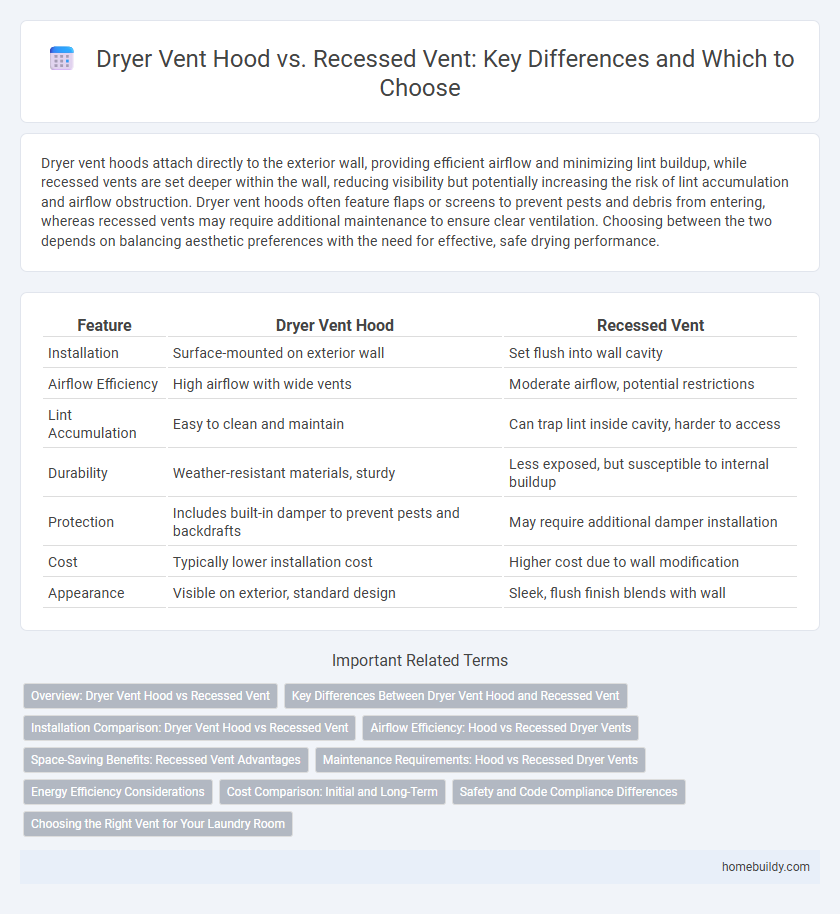Dryer vent hoods attach directly to the exterior wall, providing efficient airflow and minimizing lint buildup, while recessed vents are set deeper within the wall, reducing visibility but potentially increasing the risk of lint accumulation and airflow obstruction. Dryer vent hoods often feature flaps or screens to prevent pests and debris from entering, whereas recessed vents may require additional maintenance to ensure clear ventilation. Choosing between the two depends on balancing aesthetic preferences with the need for effective, safe drying performance.
Table of Comparison
| Feature | Dryer Vent Hood | Recessed Vent |
|---|---|---|
| Installation | Surface-mounted on exterior wall | Set flush into wall cavity |
| Airflow Efficiency | High airflow with wide vents | Moderate airflow, potential restrictions |
| Lint Accumulation | Easy to clean and maintain | Can trap lint inside cavity, harder to access |
| Durability | Weather-resistant materials, sturdy | Less exposed, but susceptible to internal buildup |
| Protection | Includes built-in damper to prevent pests and backdrafts | May require additional damper installation |
| Cost | Typically lower installation cost | Higher cost due to wall modification |
| Appearance | Visible on exterior, standard design | Sleek, flush finish blends with wall |
Overview: Dryer Vent Hood vs Recessed Vent
Dryer vent hoods are external fittings designed to efficiently expel moist air and lint from dryers, reducing risks of clogs and fire hazards. Recessed vents are installed flush with the exterior wall, offering a streamlined appearance and protection against physical damage. Choosing between dryer vent hoods and recessed vents depends on factors like airflow performance, space constraints, and aesthetic preferences.
Key Differences Between Dryer Vent Hood and Recessed Vent
A dryer vent hood typically protrudes from the exterior wall, featuring a flap or grille that opens to release hot air and lint, while a recessed vent is installed flush with the wall, offering a more streamlined appearance. Dryer vent hoods often provide better airflow and more effective lint expulsion due to their design, whereas recessed vents prioritize aesthetics but may require more frequent maintenance to prevent clogging. The key differences lie in installation style, airflow efficiency, and maintenance needs, impacting overall dryer performance and exterior wall design.
Installation Comparison: Dryer Vent Hood vs Recessed Vent
Dryer vent hoods offer straightforward installation with surface mounting on exterior walls, minimizing the need for complex ductwork or wall modifications. Recessed vents require more intensive installation involving cutting into walls for flush placement, which can increase labor time and cost. Choosing between the two depends on balancing ease of installation with aesthetic preference and space constraints.
Airflow Efficiency: Hood vs Recessed Dryer Vents
Dryer vent hoods provide superior airflow efficiency compared to recessed dryer vents by minimizing restrictions and allowing expelled air to exit smoothly. Recessed vents often create airflow turbulence and accumulate lint buildup, which reduces ventilation effectiveness and increases fire hazards. Optimizing airflow with a traditional hood vent improves drying performance and prolongs appliance lifespan.
Space-Saving Benefits: Recessed Vent Advantages
Recessed dryer vent hoods offer significant space-saving benefits by sitting flush against the wall, reducing protrusion and making them ideal for tight exterior spaces. Unlike traditional dryer vent hoods, recessed vents minimize the risk of damage from external elements and provide a sleeker, more streamlined appearance. This design also enhances airflow efficiency by shortening the vent path, contributing to improved dryer performance and energy savings.
Maintenance Requirements: Hood vs Recessed Dryer Vents
Dryer vent hoods require regular cleaning to prevent lint buildup, which can obstruct airflow and pose fire hazards, while recessed dryer vents trap more debris due to their design, increasing maintenance frequency. The vent hood's external placement allows easier access for inspection and cleaning compared to the recessed vents, which often need specialized tools or professional service. Choosing a vent hood can reduce long-term maintenance time and costs by improving ventilation efficiency and minimizing lint accumulation.
Energy Efficiency Considerations
Dryer vent hoods with streamlined designs reduce air resistance, enhancing airflow and improving energy efficiency compared to recessed vents that may trap lint and obstruct ventilation. Proper vent hood installation minimizes heat loss and prevents moisture buildup, reducing the drying cycle duration and lowering electricity consumption. Selecting vent hoods made of durable, corrosion-resistant materials ensures long-term performance and sustained energy savings.
Cost Comparison: Initial and Long-Term
Dryer vent hoods typically have a lower initial cost compared to recessed vents due to simpler installation and fewer materials required. Over the long term, recessed vents can offer better protection against pests and weather, potentially reducing maintenance and energy costs. Evaluating both options based on upfront expenses and durability is crucial for cost-effective dryer vent management.
Safety and Code Compliance Differences
Dryer vent hoods must comply with local building codes to ensure proper airflow and prevent fire hazards, whereas recessed vents often face stricter regulations due to increased risk of lint accumulation and blockage. Safety standards emphasize the need for easy access and effective moisture expulsion, criteria more easily met by traditional dryer vent hoods than recessed models. Code compliance also requires materials and designs that minimize backdrafts and pest entry, making standard dryer vent hoods a preferred choice in many jurisdictions.
Choosing the Right Vent for Your Laundry Room
A dryer vent hood provides efficient airflow and prevents debris buildup, making it ideal for exterior wall installations with limited space. Recessed dryer vents offer a flush appearance by embedding into the wall, reducing the dryer's footprint in tight laundry rooms. Selecting between these options depends on wall structure, available space, and ventilation requirements to ensure optimal drying performance and safety.
Dryer vent hood vs recessed vent Infographic

 homebuildy.com
homebuildy.com